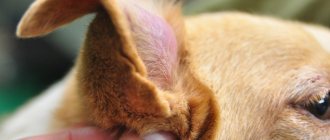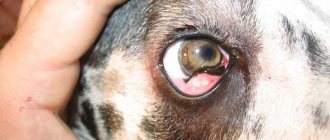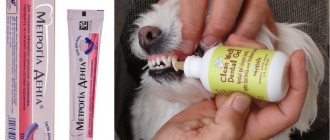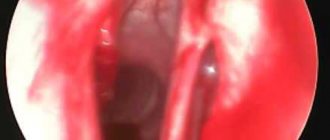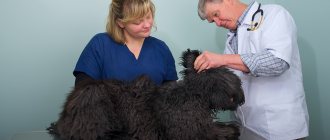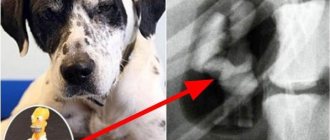Ear diseases in dogs
A large amount of thick exudate indicates illness. Plaque can be caused by:
- ear mites;
- disruption of the endocrine glands;
- allergic eczema;
- fungal infection;
- chronic otitis media.
Each of these reasons has a number of symptoms, knowing which, the owner will be able to suspect something is wrong in time. It is important to understand that it is impossible to make a diagnosis on your own, so the formation of plaque in your pet’s ears is a good reason for an emergency visit to the veterinarian, even if the pet behaves calmly and does not feel discomfort.
Brown dirt in a dog's ears
Almost every dog has suffered from ear problems at least once in its life. Diseases of this organ are especially common among long-eared breeds.
Even if your pet is not a “risk group” breed, you should pay special attention to the health and cleanliness of the ears, regularly checking them and contacting a veterinarian at the first symptoms.
It is especially dangerous when the auricle becomes inflamed, red, and a large amount of sulfur or brown dirt begins to be released from it; in this case, we can talk about the presence of a serious disease, which without proper treatment can even lead to complete loss of hearing.
Ear mite
Gray plaque in a dog’s ears is a specific symptom of otodectosis. This disease develops due to the penetration of a microscopic mite into the ear canal. In response to the waste products of the parasite, inflammation begins. Symptoms of the disease:
- Gray exudate.
- Brown dense coating and crusts.
- Redness of the skin of the ear.
- General malaise of the pet.
When a tick occurs, the dog's behavior changes. The pet becomes restless, often shakes its head and scratches its ears. The pet's appetite worsens and weight loss may occur. In older animals, otodectosis is accompanied by symptoms of general malaise - lethargy, drowsiness, and fever.
The disease must be treated promptly. Otherwise, there is a risk of perforating the eardrum, which can lead to hearing impairment.
For treatment, special drops for cleaning the ears (“Bars”) and broad-spectrum antiseptic and antibacterial agents are used. The diagnosis is made based on the analysis of dense discharge.
The structure of the ears: what is important to know
Different dog breeds have completely different ears.
The shape of the auricle determines the frequency of cleaning, as well as special care for the ear. For example, those breeds whose ears have undergone significant changes during selection require more careful care and frequent checks of the condition of the auditory canal.
But those dogs whose ears have remained practically unchanged and have a natural appearance practically do not need additional care: you just need to periodically check whether everything is normal with the shell.
From the inside, the entire surface of the dog's ear is covered with small hairs, which, due to their structure, are able to effectively remove dirt and wax outward, preventing it from accumulating in the ear canal.
If you frequently clean your dog's ears, you can damage these hairs, which will lead to a deterioration in natural cleaning. Try to resort to ear cleaning only in extreme cases - when it is clearly visible that the ear cannot cope with this function on its own.
It is also important to remember that dogs with long floppy ears definitely require ear care. Due to this composition, the ear is difficult to clean and wax can accumulate, causing various problems. At least once a week it is worth checking and feeling your pet’s ears to find out if everything is normal with them.
If the ear is dirty, smells bad, or your dog appears restless and shakes its head, this is a clear sign of some kind of problem. Even if you know how to clean your dog's ears, you should still contact a qualified veterinarian. You should not put off visiting a doctor, because hearing is very serious, and negligence is unacceptable.
Some owners think that there is no need to do such a procedure - cleaning the ears - since in the wild dogs do just fine without it. However, one should take into account the presence of strong immunity in such an animal, which has gone through many generations of natural selection, unlike a domestic pet. If you don’t clean your pet’s ears at all, this can lead to the development of a severe inflammatory process that can even cause the death of the animal.
The inside of the ear is always covered with small hairs that prevent dirt and wax from entering the ear canal. Since sulfur performs a protective function, it is not recommended to remove it again. Also, long hair grows in the auricle, which later dies and gets into the canal, clogging it. It is recommended to pluck such hair with tweezers as it grows.
When swimming, water often flows into the ears. Before the procedure, the sink must be treated with a special powder. If your pet's ears are dirty, he will shake his head frequently after sleeping. When an animal scratches its ears with its paws or walks with its head down, red-brown accumulations, that is, mites, may be to blame. Timely treatment of the ears will prevent the occurrence of most troubles and help your pet in time.
Increased activity of the endocrine glands
Brown plaque in a dog's ears does not always indicate pathology. Brown exudate may be nothing more than earwax. This secretion performs an important function - it lubricates the ear canal and protects against dust and pathogens. Excess sulfur can be a feature of the functioning of the body of a particular animal. This is usually observed in dogs that have frequently suffered from otitis media.
A large amount of sulfur is released during chronic otitis media in dogs. This is an inflammatory disease that can lead to hearing loss.
A sudden increase in sulfur production indicates a disruption in the dog's endocrine system. Recently neutered animals or older dogs may experience this. The doctor will be able to accurately understand the reasons. If no pathological disturbances in the functioning of the body are detected after the examination, treatment is reduced to regular cleaning of the ears with special lotions. It is important not to allow large amounts of wax to accumulate, as this irritates the skin and can cause itching.
Regularity of the procedure
Dog owners are often interested in how often they can clean their pet's ears. On average, this procedure is performed once or twice a week, but cleaning dogs’ ears at home depends on many indicators:
- if the dog has a lot of wax in the ears, but is healthy and behaves calmly, the contents are removed regularly as they accumulate;
- if the sink is clean, then there is no need to do anything - there is no need to injure it again;
- if the sulfur is thick, dense and difficult to remove, you can use a washing lotion, which the veterinarian will recommend;
- If there is an unpleasant odor, and if a black coating appears, the channels should be rinsed with 3% hydrogen peroxide. Using a syringe without a needle or a small syringe, a teaspoon of the product is injected into the ear canal. The dog will shake its head, so it is better to carry out the procedure in the bathroom or outside. After it, everything needs to be cleaned and wiped dry;
- If you find something strange, pus, crusts, inflammation, the dog shakes its head, tries to scratch it, whines - do not try to remove the ear mite yourself, treat otitis media or other disease - contact your veterinarian. He will make the correct diagnosis, perform the necessary manipulations and give recommendations for continuing treatment at home;
- the same goes for a tick that can bite a dog after a walk in nature in the summer. If you are not sure of your capabilities, go to the clinic, where the tick will be removed without problems and without pain for your pet.
Be attentive to your dog, regularly check the condition of the hearing organs, especially in lop-eared breeds, then your pet will not be in danger of various troubles.
The breeds most susceptible to ear infections are lop-eared dogs, such as dachshunds, spaniels, basset hounds, beagles, and some varieties of poodles. The ears of such animals are not ventilated, and dirt accumulates, especially if long or curly hair is present. This can cause the proliferation of pathogenic bacteria and fungi.
Reference! If your pet has long hair and floppy ears, ask a groomer to trim the hairs around the ears or do it yourself periodically.
READ How to leash train a puppy and an adult dog
Regular ear hygiene in these breeds is the key to your pet’s health and well-being. Supplement your care with a special powder - it will remove excess sweat and moisture from the skin folds of the ears.
Regularly monitor the condition of your pet’s ears and promptly remove dirt - this will help avoid the development of inflammatory diseases and improve your pet’s well-being. Opt for grooming products designed specifically for dog ears, as they can liquefy earwax without irritating the skin.
Whatever the breed of the dog, the procedure for all species will differ only in nuances that depend on the external structure of the ear.
Some breeds have developed hair, which interferes with work. For others, there are contraindications to the use of treatment drugs.
Otomycosis
White plaque in a dog’s ears, represented by dense crusts and flaking, is a consequence of a fungal infection. The disease is usually caused by the opportunistic yeast fungus Malassezia. It is always present in the body, but its amount increases under the influence of various factors, which leads to the development of otomycosis.
Causes of fungal infection of the external auditory canal:
- endocrine disorders;
- metabolic disease;
- weakened immunity;
- allergic reactions;
- ear injuries.
All these factors lead to excessive growth of the fungal colony, which causes inflammation. When examining the ear, you may notice small cracks and flaky areas. Dense crusts are easily removed, revealing red, inflamed epidermis underneath. With otomycosis, severe itching is observed, so the dog constantly twitches its ears, itches, and shakes its head.
To make a diagnosis, it is necessary to analyze a scraping of the white discharge. In therapy, antiseptic agents, antibacterial drops are used if there is a risk of secondary infection, and local antifungal agents are used to eliminate pathogenic microflora.
What to do?
If a dog’s ears smell bad, then the most useful thing for the owner to do is to clean them with cotton swabs once a week, for dogs with short ears - more often, taking utmost care not to damage the eardrum and do an analysis of the ear flora .
If your ears are clean, there is no need to treat them! It is common to see dark brown, sticky wax in the ears, which is a natural defense against small debris and bacteria that cause inflammation. Getting rid of it is not difficult.
How to remove a slight odor? It is enough to clean your ears with a special lotion sold in a pharmacy, a solution of chlorhexidine, or saline solution (mix boiled water with a small amount of salt). You cannot clean your ears with hydrogen peroxide, because... You can irritate or even burn the delicate skin inside your ear canal!
To clean the ears of large dogs, it is better to use a cotton pad; for small dogs, it is better to use a cotton swab.
However, remember that wax itself protects the ear and even kills harmful bacteria! It is produced in the external auditory canal and, moving towards the auricle, absorbs dead skin cells, dust, and sebum.
We recommend reading: Cat Vomits After Feeding
A very important point: when cleaning, you cannot climb into the ear canal itself! This can only be done by a doctor using instruments designed for this purpose!
We can only clean the ear on our own, i.e. what's outside. There is sulfur there, which has already lost its beneficial properties and has become a favorable environment for the development of bacteria.
Why your dog smells like dog, fish or rotten meat: we solve problems quickly
Eczema and injuries
Black plaque in a dog's ears may indicate injury to the external auditory canal. In this case, the dark color of the exudate is due to inclusions of blood. To diagnose an injury, you need to carefully examine your pet's ears. Damage may be caused by foreign objects.
Allergic eczema is a severe form of an allergic reaction that occurs in response to medications, household chemicals and hygiene products for cleaning the ears. Characteristic symptoms:
- Dark, almost black coating.
- Severe peeling.
- Formation of cracks and erosions.
- Sores around the ear.
Antihistamines and anti-inflammatory ointments are used to treat eczema. The treatment regimen is selected by the veterinarian individually for each animal, depending on the severity of symptoms and general health.
Otitis.
Otitis. Otitis is called inflammation in the ears. Depending on the location of the lesion, there are: external, middle and internal. Of course, the deeper the inflammation process, the greater the danger it poses to the dog. However, it should be understood that seemingly harmless otitis media of the external ear, if left untreated, can lead to deformation of the eardrum, and this already poses a threat to the animal’s hearing. A complication of internal otitis can be inflammation of the meninges; the likelihood of death with this disease is quite high. Unfortunately, dachshunds are also at high risk in this case, due to the fact that the auricle under the long ears is warm and humid, which is favorable conditions for the development of bacteria. With otitis media, the dachshund's ears itch and the discharge smells bad.
